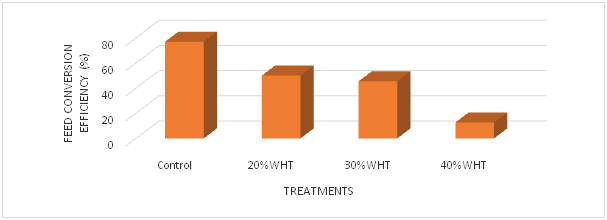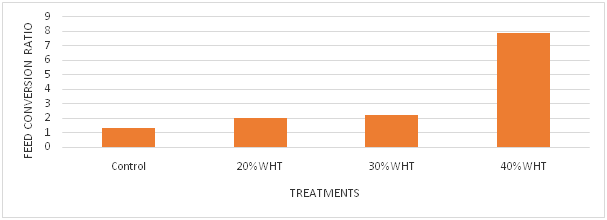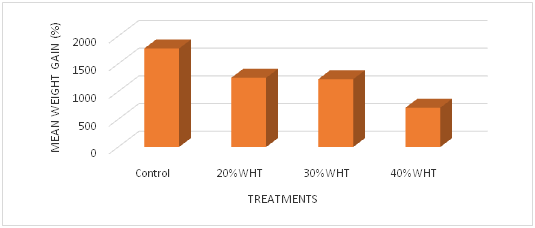Advances in
eISSN: 2373-6402


Research Article Volume 8 Issue 6
1Nigerian Institute for Oceanography and Marine research, Victoria Island, Lagos-State, Nigeria
2University of Lagos, Akoka, Lagos, Nigeria
Correspondence: Fola-Matthews O, Nigerian Institute for Oceanography and Marine research, Victoria Island, Lagos-State, Nigeria,
Received: May 01, 2018 | Published: December 28, 2018
Citation: Fola-Matthews O, Kusemiju K. Growth pattern and proximate composition of the African catfish clarias gariepinus, L. fed on water hyacinth substituted diets. Adv Plants Agric Res. 2018;8(6):617-622. DOI: 10.15406/apar.2018.08.00394
The resourceful utilization of the water hyacinth plant, Eichhornia crassipes as an inclusion in the preparation of fish feed substitute in order to reduce the cost of fish feed production was examined in this study. 80 fingerlings of Clarias gariepinus were used with four feeding regimes (Control 0%, 20%WH, 30%WH and 40%WH) with a duplicate of each regime at ten specimens per tank. The fingerlings were fed at 5% of their body weight for a period of ten weeks in the Laboratory. Temperature varied between 26.5°C–28.9°C, pH between 7.2-7.9, Dissolved oxygen between 4.0-5.3mg/L and salinity between 5.0–7.3‰. There was an observed decrease in the growth performance indices as the level of WH substitution increased. Proximate analysis of fingerlings carcass after the experiment recorded crude protein value of 53.9% in the control treatment, 31.9% crude protein in the 20% WHT, 29.3% in the 30% WHT and 20.7% crude protein in the 40% WHT. The cost of feed production decreased as the inclusion level of water hyacinth increased. The control treatment recorded the highest values (2.95, 2.1) for the profit index and benefit cost ratio respectively, 20% water hyacinth treatment recorded (1.8, 1.35), 30% WHT recorded (1.75, 1.2) while the 40% WHT recorded the least values of (0.8, 0.55). Therefore, taking into consideration the overall growth performance as well as the cost of production, the 20%WHT can be recommended. For further studies, levels lower than 20% WHT can be tested.
Keywords:Clarias gariepinus, water hyacinth, growth performance, benefit cost ratio
Fish feed generally constitutes 60-70% of the operational cost in Intensive and semi-Intensive aquaculture systems.1 Considering the importance of nutritionally balanced and cost-effective diets for fish, there is a need for research effort to evaluate the nutritive value of different non–conventional feed resources that includes terrestrial and aquatic macrophytes. According to Kusemiju and Akingboju2 the shortage and high cost of conventional pelleted feed has severely constrained the development of low-cost aquaculture systems suitable for small scale farmers in the developing world, hence, the need to assess the potential of non-conventional fish feeds such as water hyacinth, Eichhorniacrassipes (Mart) Water hyacinth is a free floating macrophyte. It lies at the air-water interface and forms two distinct canopies. It can withstand a wide range of environmental conditions. The reports of Boyd3,4 on the chemical analysis of water hyacinth indicated that it contains high fibrous cell wall materials, mainly cellulose but very rich in amino acid profile,5 essential vitamins,6 and 11.34 crude protein.7 In developing countries, this plant is used in traditional medicine and also to remove toxic elements from polluted water bodies.8 Recently, more focus has been given to its harvesting for practical uses, as an alternative source of plant protein in livestock feed including fish.9,10 Clarias gariepinus, belongs to the family Clariidae. This specie has maintained its aquaculture quality because of its high growth rate, large size, and good flesh quality, tolerance to poor water quality, acceptance of cheap feed, disease resistance and good taste.11,12 It is majorly cultured for its omnivorous feeding habit as it readily accepts different kinds of unconventional feed ingredients included in its diet.13,14 This study was aimed at determining the growth pattern and nutritive value of fish fed on varying levels of water hyacinth based diet. It further evaluates the economics of water hyacinth as a plant protein substitute in the feeding of Clarias gariepinus fingerlings.
This study was carried out at the Marine Research Laboratory of the Department of Marine Sciences, University of Lagos, Nigeria.
Experimental fish
The rationale of selecting C. gariepinus is due to its omnivorous feeding habit as it readily accepts different kinds of unconventional feed ingredients included in its diet. A total of 80 fingerlings of C. gariepinus (total length; 8.5–10.5cm; total weight; 4-7g) were used. They were fed formulated experimental diet twice daily at 5% of their total body weight for ten weeks.15 There were four feeding regimes each with a duplicate tank at ten specimens per tank (Control 0%, 20%WH, 30% WH, 40%WH). Each group of fish were weighed every 14th day and the quantity of feed administered adjusted accordingly.
Collection and processing of water hyacinth
Whole water hyacinth plant was picked fresh along Ogun River with the assistance of fisher folks. The plant was solar dried for two weeks and grinded with the aid of a willey mill using 0.1mm mesh screen. The plant was analyzed for crude protein, crude fat, crude fibre, ash and moisture (Table 1).
|
Components |
Composition |
|
Crude Protein |
17.29 |
|
Crude Fat |
2.35 |
|
Crude Fibre |
16.57 |
|
Ash |
4.5 |
|
Moisture |
15.22 |
Table 1 Proximate Composition of the water hyacinth plant used for this experiment
Preparation of the experimental diet
The grinded water hyacinth plant is mixed in accordance to its percentage substitution with the coppens diet. The ingredients were thoroughly mixed and pelleted wet using a kitchen hand crancker pelletizer (Table 2).
|
Tank |
Feed type |
|
A1 & A2 |
Formulated Coppens feed only (Control) |
|
B1& B2 |
20% dried WH; 80% Coppens diet |
|
C1& C2 |
30% dried WH; 70% Coppens diet |
|
D1 & D2 |
40% dried WH; 60% Coppens diet |
Table 2 Composition of experimental diets
Physico-chemical analysis
Physico-chemical parameters of the test media were monitored weekly during the 10 weeks duration of the feeding trial. The parameters measured were dissolved oxygen, pH, salinity and temperature.
Determination of dissolved oxygen (DO)
The dissolved oxygen (DO) was measured using a DO meter (ADWA) Model DO600.
Determination of pH
The pH or Hydrogen ion concentrations were determined using a Phillips pH meter (Model 9405) with glass electrode. The electrodes were standardized using buffer solutions and then washed with sample water to be tested and dipped into the sample water and the pH read on scale.
Determination of salinity
The salinity was determined using a refractometer (BBIOMARINE, Aqua Fauna Model)
Determination of Temperature (℃)
The temperature of the water was determined using the Horiba U-10. The probe was inserted into water for five minutes, while the calibrated temperature measured in degree Celsius (℃)
Estimation of growth and nutrient utilization
The Fortnight weight and feed fed to fish were used to compute the growth and nutrient utilization parameters following the method of Olivia-Teles (2001).16
Analysis of the cost/profit
The economic analysis was computed to estimate the cost of feed required to raise a kilogram of fish using the various experimental diets. The major assumption is that all other operating costs for commercial fish production will remain the same for all diets. Thus, cost of feed was the major economic criterion in this study. The cost was based on the current prices of the feed ingredients as at the time of purchase. The cost of producing water hyacinth meal was put as processing costs. The economic evaluations of the diets were calculated from the method of economic evaluation in terms of Investment cost analysis (ICA), Net profit value (NPV), Gross profit (GP), Profit index (PI), Incidence of Cost (r) and Benefit cost ratio (BCR) of the C. gariepinus fingerlings during the feeding trial experiment according to Madzi et al.,17 as follows:
Proximate composition
The proximate Composition was assayed as described by AOAC.18 All chemicals used were of analytical grade and supplied by Sigma Co. (St.Louis, USA). Each analysis was carried out in triplicates.
Statistical analysis
Data collected were subjected to analysis of variance test (ANOVA). Using statistical package for the social science (SPSS) computer software 1988 version 10.0 of the Chicago Illionis (USA). Comparisons among treatment was carried out by Duncan Multiple Range Test at a significance level of 0.05. Duncan19 Microsoft Excel Package was used to plot the graph.
The mean, standard deviation and range of the physico-chemical parameters; temperature, pH, dissolved oxygen and salinity are presented in Table 3. Growth performance of C. gariepinus fingerlings fed on WH based diets for 70days is represented in the figures below. Accordingly, results of the study revealed that the mean weight gain of fingerlings was the highest for control ((1778%) while, the lowest was recorded in the 40% WHT (Figure 1). SGR and FCE values of the fingerlings is represented in Figure 2 & Figure 3 respectively. SGR values recorded in control treatment is 1.82g/day and 1.29g/day for 40% WHT. The FCR values of fingerlings in the control treatment was 1.3 and 7.85 in the 40% WHT. The lowest feed conversion value was in the control treatment and is therefore the best feeding regime in this experiment. This infers that the fingerlings in the control treatment were able to convert 1.3 unit weight of feed into a unit weight of muscle (Figure 4). Results for the condition factor (K), initial and final is shown in Figure 5. Carcass analysis also revealed that the control diet’s fingerlings had the highest value of fat, 20% had the highest level of ash while the 40% had the highest level of carbohydrate; Table 4. The result of the production cost of the experiment and economic indices is presented in Table 5. Highest profit index of 3.0 was obtained from the control, while the lowest index of 0.8 from 40%WHT likewise, maximum benefit cost of 2.1 was recorded in the control while the minimum value of 0.6 was recorded in the 40% WHT.
|
Parameters |
Control diet |
20% WHT |
30% WHT |
40% WHT |
|
Temperature (℃) |
26.5 – 28.9 |
26.5 -28.7 |
26.5 – 28.6 |
26.5-28.5 |
|
(27.62±0.80) |
(27.51±0.73) |
(27.52±0.73) |
(27.48±0.67) |
|
|
Salinity (‰) |
5.0 – 7.0 |
5.0 – 7.0 |
5.0 – 7.0 |
5.0 – 7.0 |
|
(6.4±0.84) |
(6.4±0.84) |
(6.4±0.84) |
(6.4±0.84) |
|
|
Dissolved oxygen (mg/L) |
4.0 – 5.0 |
4.0 – 5.0 |
4.0 – 5.0 |
4.0 – 5.0 |
|
(4.4±0.52) |
(4.4±0.52) |
(4.4±0.52) |
(4.4±0.52) |
|
|
pH |
7.2-7.9 |
7.3-7.5 |
7.2- 7.8 |
7.3-7.7 |
|
|
(7.50±0.23) |
(7.41±0.08) |
(7.47±0.17) |
(7.3±0.65) |
Table 3 Summary of mean (±SD) physic-chemical parameters in the experimental tanks during the feeding trial experiment

Figure 3 Feed conversion efficiency of Clarias gariepinus fingerlings after the feeding trial experiment.

Figure 4 Feed conversion ratio of Clarias gariepinus fingerlings after the feeding trial experiment.

Figure 5 Initial and final condition factor of Clarias gariepinus fingerlings after the feeding trial experiment.
|
Moisture |
Fat |
Protein |
Ash |
Crude fibre |
Carbohydrate |
|
|
0% |
70.12± 1.37b |
0.60± 0.14a |
53.94 ±7.48b |
1.03± 0.53a |
1.27± 0.52a |
22.50 ±0.04b |
|
20% |
68.29 ±0.05a |
1.60± 1.15b |
31.90± 4.28a |
1.49± 0.18b |
0.88± 0.52a |
23.28± 2.07a |
|
30% |
69.55± 1.02b |
2.28± 1.25c |
29.27± 5.15a |
0.59± 0.18b |
0.62± 0.15a |
28.00± 0.49c |
|
40% |
66.59± 1.35a |
0.31± 0.46a |
20.72± 5.94a |
0.81± 0.39a |
0.76 ±0.33a |
28.93± 0.25c |
Table 4 Summary of the statistical analysis of the proximate composition (%wet weight) of the fingerlings carcass at the end of 70days feeding trial
|
Parameters (#=Naira/Nigerian currency) |
0%WHT |
20%WHT |
30%WHT |
40%WHT |
|
Total feed consumed (g) |
511 |
585 |
464 |
385 |
|
Cost of stocked fingerlings |
200 |
200 |
200 |
200 |
|
(#20 / fingerling) |
||||
|
Cost of feeding coppens (#950/kg) |
486 |
556 |
465 |
366 |
|
Total expenditure (#) |
686 |
756 |
641 |
566 |
|
Value of fish cropped |
1445 |
995 |
790 |
305 |
|
Assumed (#3/g each) |
||||
|
Profit (#) |
759 |
257 |
129 |
260 |
|
Mean weight gain (g) |
406 |
287 |
213 |
49 |
|
Incidence of cost (#/g) |
1.3 |
2 |
2.1 |
7.5 |
|
Profit index |
3 |
1.8 |
1.8 |
0.8 |
|
Benefit cost ratio (BCR) |
2.1 |
1.4 |
1.2 |
0.6 |
Table 5 Economic Indices of Clarias gariepinus fingerlings during the feeding trial experiment
The temperature recorded during this feeding trial ramged from 26.5-28.9℃, this range is in line with the recommendation by Bhatnagar & Devi20 who reported that a temperature range of 20- 30℃ was tolerable for the culture of C. gariepinus. Dissolved oxygen from this study was between 4-5mg mg/L. Bhatnagar & singh21 stated that dissolved oxygen level above 5mg/l is essential to support good fish production. According to Santhosh and Singh, 2007, catfishes and other air breathing fishes can survive in low oxygen concentration of 4mg/L, therefore, dissolved oxygen levels of 4.0mg/L observed in this study is tolerable to the fingerlings. pH values ranged from 7.2-7.9 in this study which is suitable as Ekubo and Abowei,22 observed that pH values ranging from 7 to 8.5 is optimum and conducive for fish life. The results of this study showed that highest K (condition factor) value was recorded in the control treatment (1.02) while the least was recorded in the 40% WHT (0.81). A study conducted by Olurin & Aderibigbe23 describes that a well fed fish will have a higher condition factor than a poorly fed one. The FCR of fingerlings fed on the 40% WHT was highest (7.9) while the least value was obtained in the control treatment (1.3), with the 20% WHT value following closely (2.0). The low FCR values of both the control and the 20%WHT indicates that the fish could easily digest the feed and convert the feed more efficiently into their body mass. Inclusion of water hyacinth significantly increases the crude fibre content of the feed. This probably affected the FCR and feed utilization of the 40%WHT fingerlings. The SGR value was significantly higher (P˂0.05) in the control than all other treatments. A significant difference was observed in the 20% and 30% WHT but there was no significant difference (P˃0.05) in the 40%WHT.
This illustrates that the fingerlings under this control treatment took adequate advantage of the diet better than other diets. The percentage MWG was highest in the control treatment (1,778%) and least in the 40%WHT (709%). The significantly low weight gain and SGR of the fingerlings fed 40%WHT may be due to the high fibre content (18.16%) present in the plant. This observation is in conformation with the reports of Nwanna et al.,24 who reported poor fish growth performance when fed with crude fibre above 4.75. It was then suggested that the water hyacinth plant could be processed in order to bring its crude fibre content to the lowest possible level and consequently increase its digestibility. The control, 20%WHT and 30%WHT showed a significant difference (P˂0.05) in the statistical analysis of the FCE, while the 40%WHT obtained the lowest value and showed no significant difference. Crude fibre showed no significant difference (P˃0.05) in all the treatments in the proximate analysis done, but a resultant significant difference was observed in the control treatment for the crude protein value. Proximate analysis of the carcass indicates an higher level of protein (53.94%) and moisture (70.21%) in the control treatment, the highest value of carbohydrate was in the 40% WHT (28.93%), with 20% and 30% WHT having the highest level of fat (1.60%, 2.28%) respectively. The increasing trend in protein value of the coppens diet was however expected. The other treatments (20%, 30% and 40%) also recorded considerable high protein values (32%, 30% and 21%) respectively. These values were quite high in comparism to the work of Osibona et al., 2006 who reported a protein value of 19.6% from C. gariepinus obtained from Lekki Lagoon fishing grounds in Lagos. The cost of production and the benefit of costs positively favoured all the treatmants except that of the 40%. All the values obtained were greater than 1.0 which indicates an increase in the fish value above the amount invested. This shows that BCR values of 1.4 and 1.2 obtained from the 20% WHT and the 30%WHT respectively are both economically viable. Soyinka and Kusemiju25 reported the highest percent weight gain (125.81%), feed conversion ratio (2.51), feed conversion efficiency (39.78%), condition factor (2.59) and specific growth rate (0.86g/day) in the 40% water hyacinth diet in the feeding trial of Mugil cephalus.
This study illustrates that in order to make resourceful use of the water hyacinth weed; it can be used as a substitute in the diet of Clarias gariepinus. During the course of this experiment, the control treatment had the best performance in all the parameters analyzed, but when making an allowance for a lesser overhead cost for the farmer, the 20%WHT is desirable, as most of its values obtained in all the parameters assayed showed no significant difference when compared with the control treatment. The 20%WHT is feasible and will yield profitable returns for the farmer as well as making a resourceful use of the weed.
None.
The authors declared there is no conflict of interest.

©2018 Fola-Matthews, et al. This is an open access article distributed under the terms of the, which permits unrestricted use, distribution, and build upon your work non-commercially.